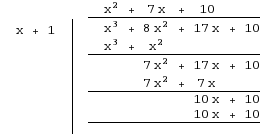How do you factor #y=x^3+8x^2+17x+10 #?
1 Answer
To get started, you will have to find a factor. This can be long. Use the remainder theorem to test possible factors. The possible factors are given by the rational root theorem. See below for more details.
Explanation:
The rational root theorem states that in a polynomial
Therefore, we can state that the possible roots are at (factors of 10)/(factors of 1). Listing these, we get:
Simplifying further:
Here comes the part that can be long. The remainder theorem states that for any polynomial function
When I do this, I tend to go from positive to negative, from smallest to largest. From experience, it is relatively rare for you not to find a factor by
Therefore,
We must now divide
The following image shows the long division (you could have also used synthetic division).

As you can see, the quotient is
This can easily be factored by finding two numbers in
Therefore,
or
Hopefully this helps!

